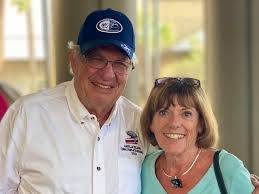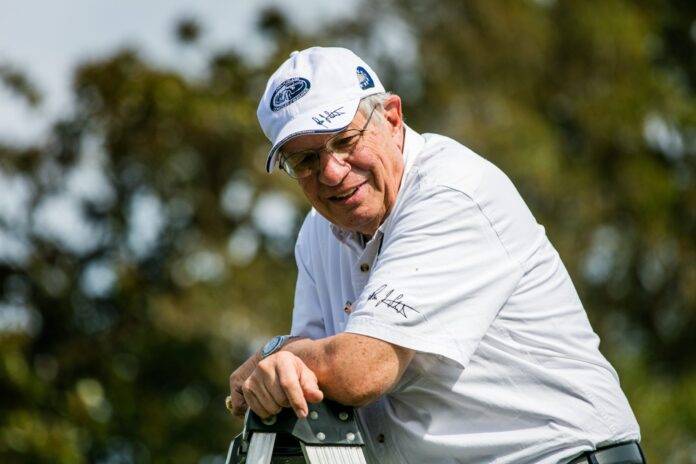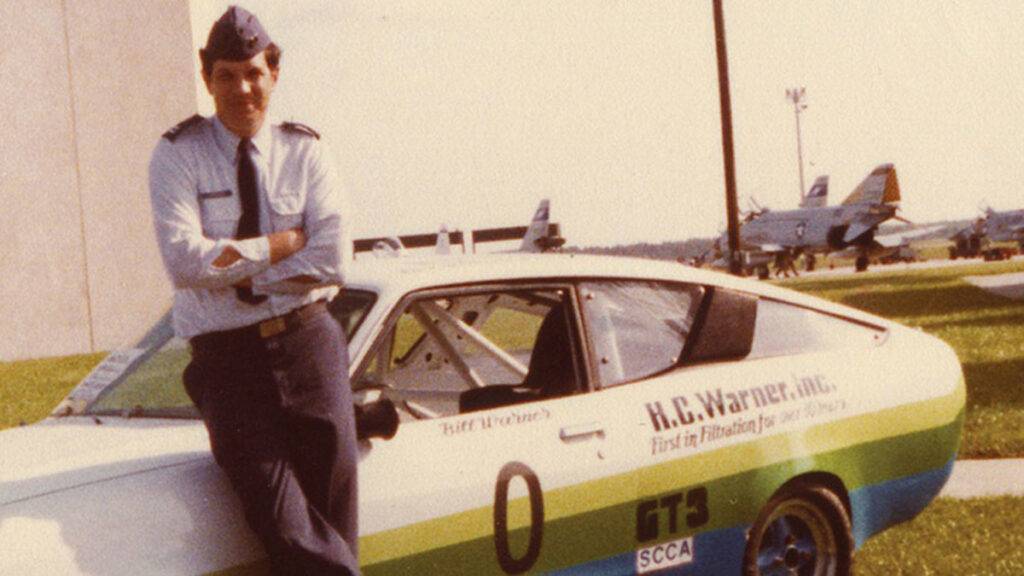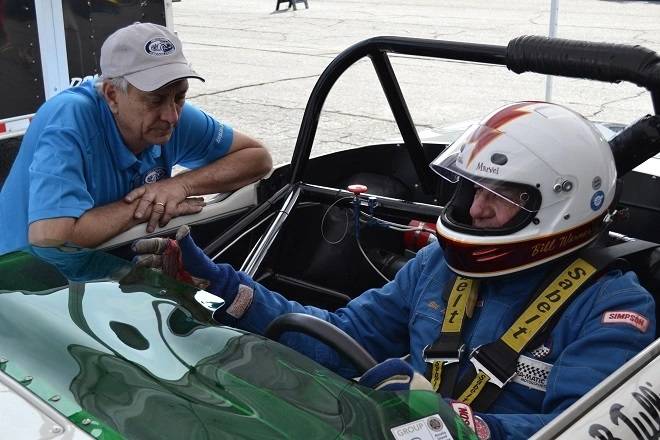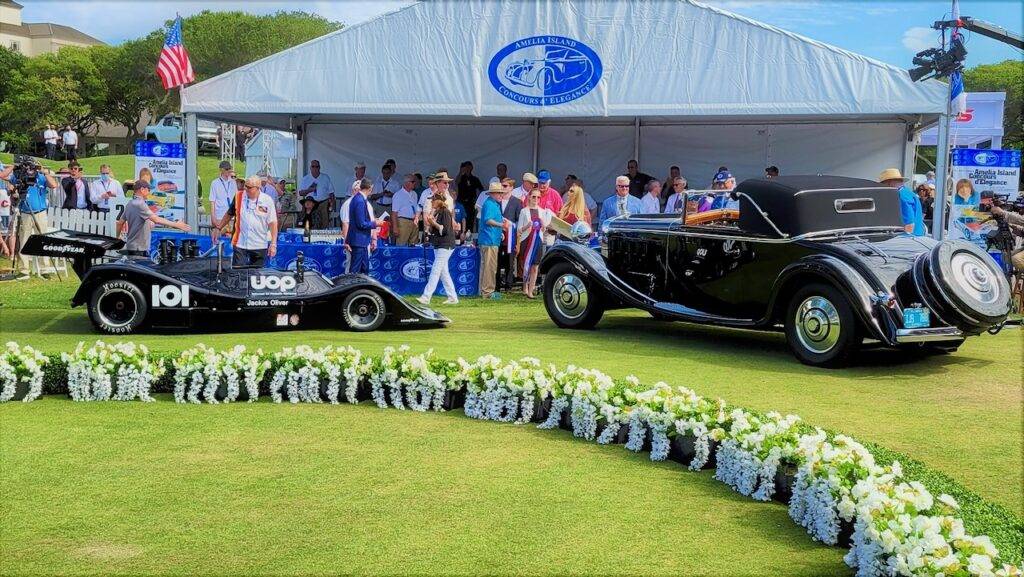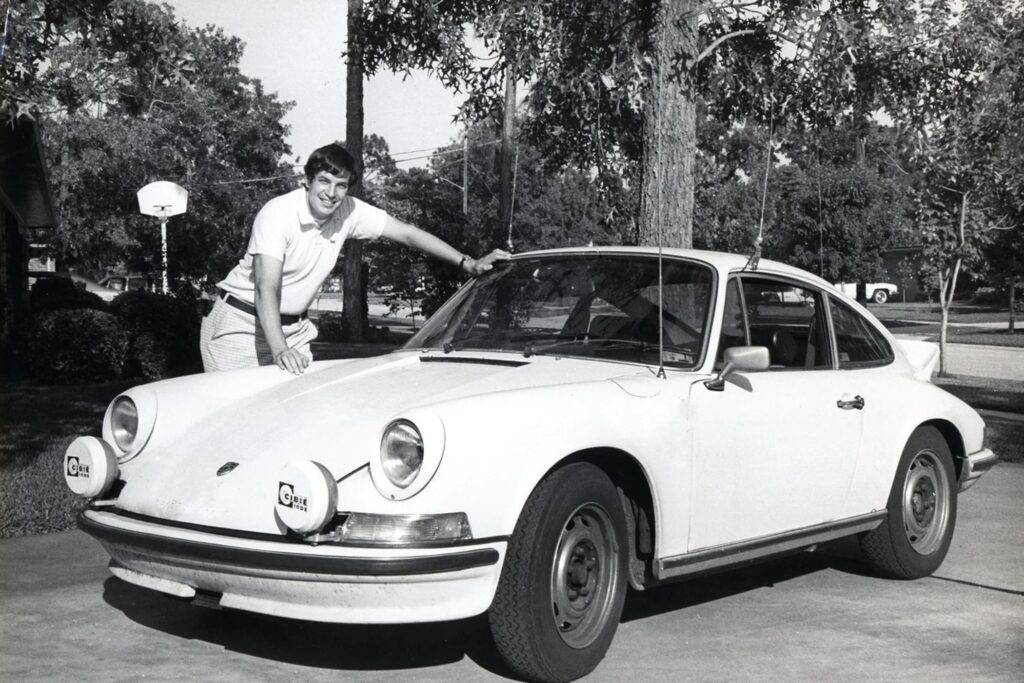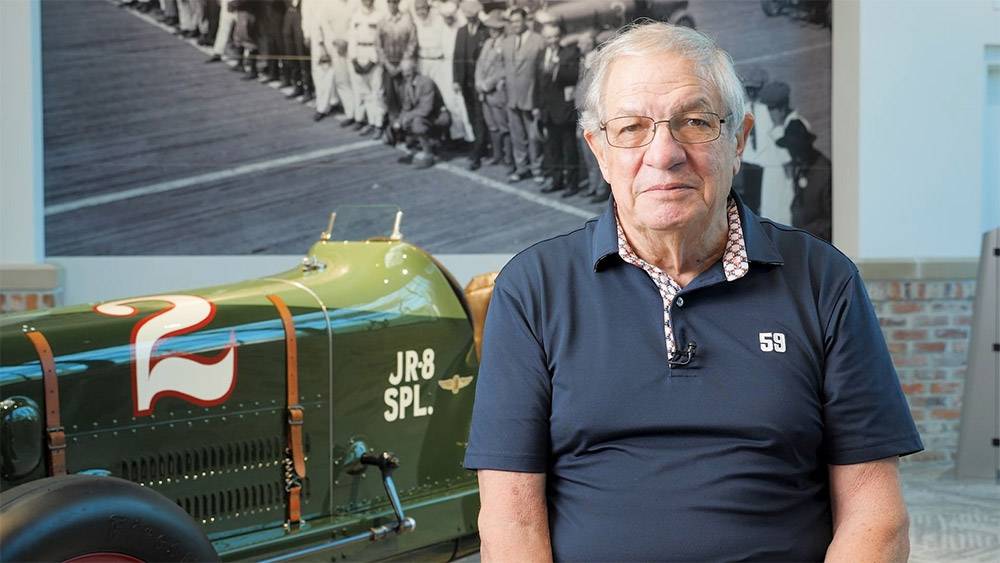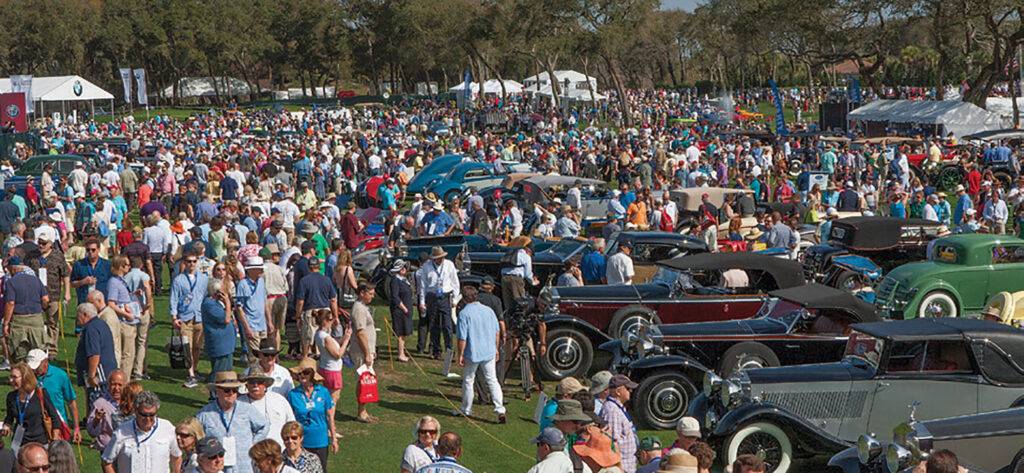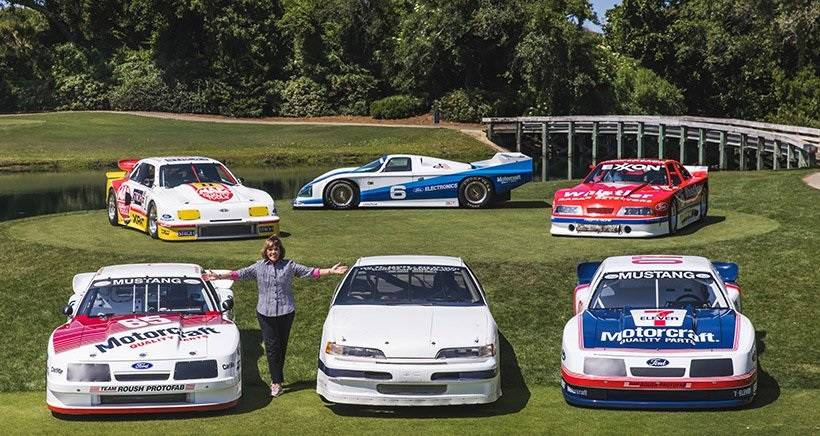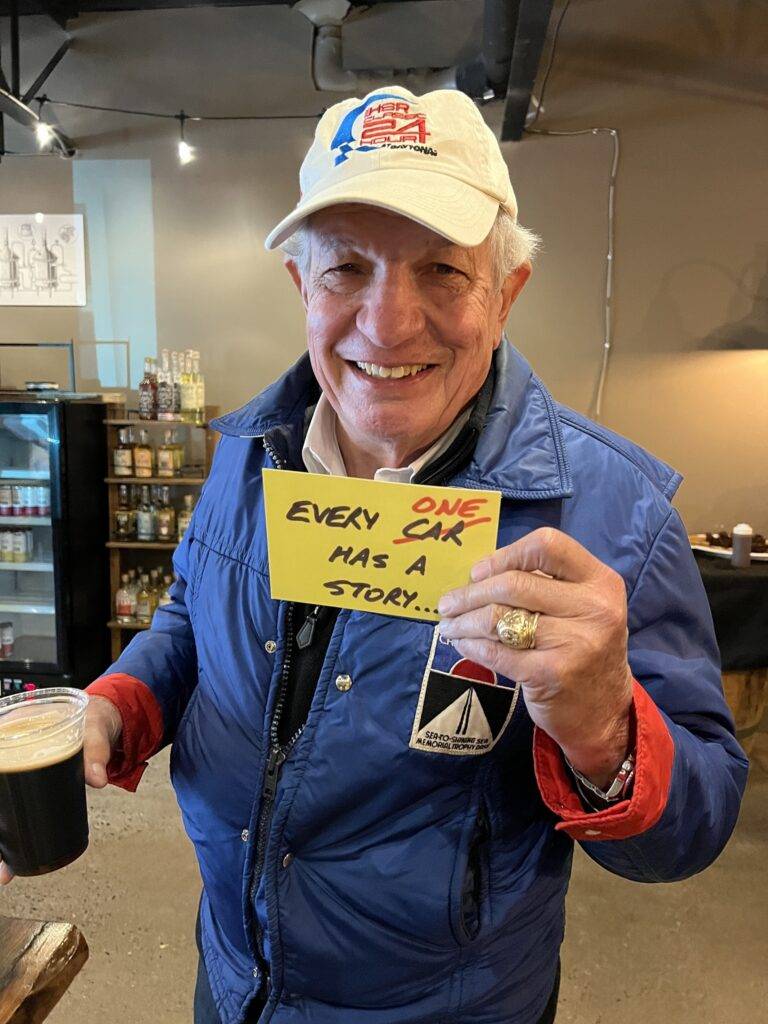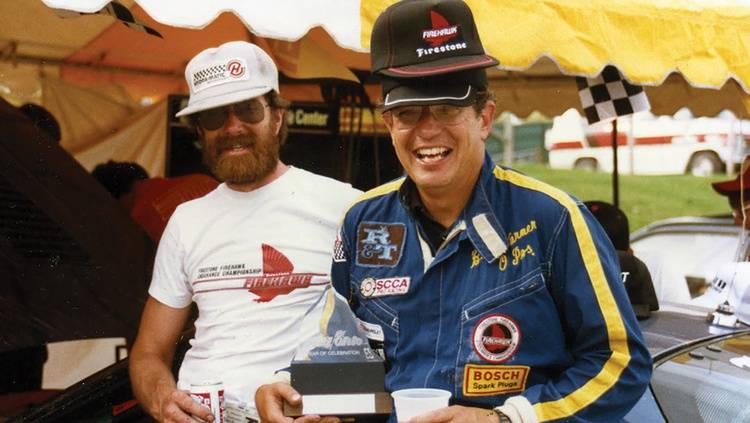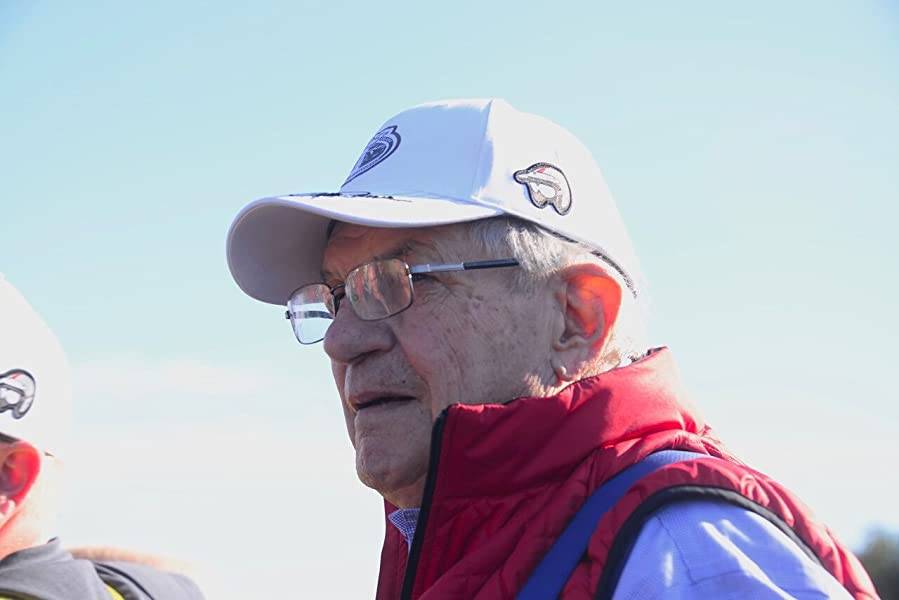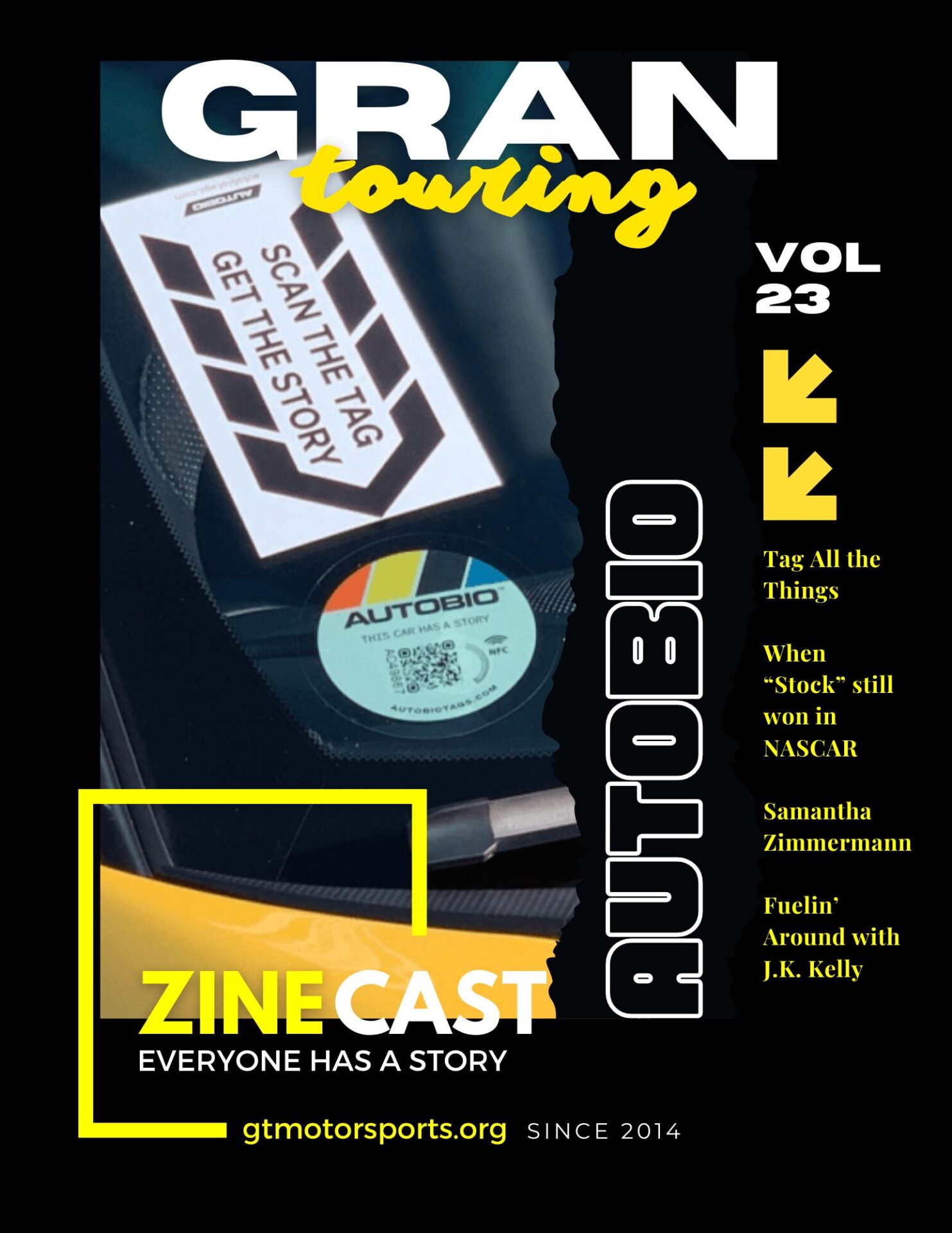Crew Chief Brad: [00:00:00] BreakFix podcast is all about capturing the living history of people from all over the autosphere, from wrench turners and racers to artists, authors, designers, and everything in between. Our goal is to inspire a new generation of petrolheads that wonder, how did they get that job or become that person?
The road to success is paved by all of us because everyone has a story.
Crew Chief Eric: The following episode is brought to us in part by Garage Style Magazine. Since 2007, Garage Style Magazine has been the definitive source for car collectors, continually delivering information about automobilia, Petroliana, events, and more.
To learn more about the annual publication and its new website, be sure to follow them on social media at Garage Style Magazine, or log on to www. garagestylemagazine. com. Because after all. What doesn’t belong in your garage?
Tonight’s guest has been around [00:01:00] automobiles his entire life. On weekends, he worked as a gopher for the dealership racing team and became enthralled with motor racing. His photographs and writing have appeared in Road Track, Car Driver, AutoWeek, The Atlantic Monthly, Automobile, Automotor und Sport, Classic and Sports Car, Porsche Panorama, and Forza, to name a few.
He has competed in the cannonball Baker Sea to Shining Sea Memorial Trophy Dash, known to many of us as just the cannonball run. as well as the Firestone Firehawk series, winning the IMSA Media Challenge for Racing Journalists in 1984 through 86. And if that wasn’t enough, he also restores and collects interesting cars.
So who exactly are we talking about? Acclaimed author, photographer, racer, car collector, and all around petrolhead, none other than Bill Warner. who in 1996 also founded the Amelia Island Concours d’Elegance near his home of Jacksonville, [00:02:00] Florida. And we welcome him to BreakFix to share some amazing stories with all of you.
So welcome to BreakFix, Bill. Thank you. I don’t know how amazing they’ll be, but we’ll, we’ll make up some stories. That’s the first thing we learn is racers, right? Making up excuses and making up
Bill Warner: stories. The older I get, the faster I was.
Crew Chief Eric: So let’s talk about that. Let’s talk about how you got your start. I hear rumor that you actually got your start in Volkswagen’s.
Bill Warner: Well, I worked for Al Sager Volkswagen when I was 16 years old driving the parts truck and the courtesy truck, which was a Volkswagen Combi. And he had a racing team and they had two Porsche powered specials, both with, uh, one had a cobbled up Devon body and one with a stock Devon body. And I used to go to them to the race.
And when I was 16, 17, that’s before there were restrictions on getting into the paddock at 18. And I’d schlep tires and get coffee and do whatever they needed to get done and smell that castor bean oil and heard the noise and that was hooked for life. Did you start your career in [00:03:00] motorsport first or in journalism first?
It was motorsports working for Mr. Sager. I graduated from the Citadel in Charleston, which is a very strict military college. And I found out that if you were a photographer on the yearbook staff, you didn’t have to march and parade on Friday. I became a photographer. My sister was a professional photographer, and my parents gave me a camera when I was 16, and I would take it to the races.
And then I couldn’t afford to go racing when I was first married at 23. So I started working for sports car graphic magazine, shooting races at Daytona. Magazine being historically cheaper to hire me to come from Jacksonville to Daytona than it was to fly someone from Los Angeles. I think the first paid job I did was the SCCA runoffs.
I think in 67, I think at Daytona. It just kind of took off from there. Then in 1971, Sports Car Graphic was eliminated from the Peterson Group. Road and Track was looking for somebody down here. So I went on with Road and Track. I couldn’t make a living working for those guys. I had a business on the side, not a side business, a primary [00:04:00] business selling filtration equipment.
Crew Chief Eric: So when did you get into racing cars and what did you race first?
Bill Warner: My first race car was a Brabham BT eight, and I ran the very first or second vintage race at Sebring, Florida at 78. And I found the car in the South Carolina junkyard. When I was on the road selling filters, I’d go to junkyard and repair shops looking for cars.
Strangely enough, I was looking for a birdcage Maserati and I ran into a friend of mine in a newsstand in Columbia. And we were talking about birdcages. I said, I was looking for one. He said, Oh, there’s one in a junkyard here. So, you know, I asked him how long it would take to get there and he said 10 minutes and said, let’s go.
So we went out there and it was a 450s and it was gone. But the guy says, I got a Brabham. I said, well, I’m not interested in the formula car. And he says, no, this is a sports racer. And I went out and Brabham made two sports racers, a BT5. They made two of those and a BT8. They made 12 of those. And this was the BT8 that Denny Holm won the tourist trophy in and was undefeated in under two liter racing.
And it was just sitting there in the South Carolina junkyard. I
Crew Chief Eric: bought it for 2900 bucks. If we’re watching our years correctly [00:05:00] here, you would have started your motorsports career three years after the inaugural cannonball run, which was in 1975. How did you get involved in the cannonball run? And what made you decide to take on that challenge?
But what car did you run during the race? I knew Brock Yates through my
Bill Warner: connections at Road and Track. He was a car and driver. He and, uh, John Graves were in town one time. John won the Daytona 24 hour and the Curious Cargo Porsche. And we’d rent a go kart track and go racing at night. And then we’d go drinking at night.
So between drinking and racing, Brock said he was going to run another cannonball. And I’d never been to California at that time. I was, what, 32 years old. It just seemed like a good idea to go. So I had a Porsche 911 I bought in 71. So it was four years old and we put a 31 gallon gas tank in it from George Drolson’s Carrera and a radar detector.
And Tom Neal, who owned the GMC truck dealership, who I later raced Camaros with, he and I decided to do the cannonball just for grins. We didn’t have any particular aspirations of [00:06:00] winning. In fact, we made some bad decisions on the route. It was just a LARP. We never thought it would be a cult thing years later, but we just did it for a LARP.
How long did it take you guys? 41 hours. We were terrible. We went the southern route. One of the deals that you had to agree with with Brock that you wouldn’t discuss when it was going to happen and some clown from Ohio bragged about it to a newspaper which published it. And the Ohio and Indiana Highway Patrol were going to be out looking for us, so we decided to go down through Knoxville, Tennessee and across Arkansas to Oklahoma City.
All the routes came together and that was a bad decision. That cost us two hours. We would’ve been in about 39 hours had we gone the, the route everybody else ran, but we thought we were too smart for that.
Crew Chief Eric: How far could you go on 31 gallons. How often did you have to switch drivers? About 600 miles, farther than our bladders would go.
So how long were your stents behind the wheel? Obviously with two men in in the car, you could switch off. That’s a funny story. I
Bill Warner: started in New York and it was about seven o’clock in the evening and along about two in the morning. We were down in [00:07:00] Virginia and I turned it over to Tom. I noticed his head was bobbing like he was going to sleep.
And I said, what’s wrong? He said, never could drive at night. I said, well, this is a heck of a time to tell me that we still got 2, 400 miles to go. So I drove from New York City to Knoxville, Tennessee, and then he drove to I think Little Rock. And then I drove from somewhere west of Little Rock to Needles, California.
And he woke up. And then he drove from Needles into Portofino Inn at Redondo Beach. I got where I was pretty wasted by the end of that trip.
Crew Chief Eric: The 9 11 was reliable the whole way through? No issues? Oh, 9 11’s are bulletproof. What were some high or low points during that cross country journey? Well, all the routes came
Bill Warner: together in Oklahoma City.
And we had a list of all participants with their CB handles. And my license plate, Florida license plate, is Shazam. My CB handle is Captain Marvel. That’s pretty cool. And I had just signed off with a trucker going eastbound, and I said, uh, the Captain Marvel were gone. And I hear this, how about you Captain Marvel?
I [00:08:00] said, who we got there? He says, the Sundance. I looked down my list and I couldn’t find a Sundance. I said, uh, I don’t know any Sundance. He came back, he says, does a Portofino Inn mean anything to you? And I said, oh yeah. So I knew it was one of the other cannonballers, and it turned out to be a Ford van sponsored by Heiser Cycle Shop in Towson, Maryland.
They had a bed in the back and they were running this Econoline van or whatever, it was coast to coast, and he says, what’s your 20? What’s your location? I said, we’re at the 62 mile marker. We’re at 64. I said, ah, geez. I said, we’re behind the van. We made a bad decision going to Southern Route. So I picked it up to about a hundred miles an hour.
We were just west of Oklahoma City, and I said, we’re at 64. We’re at the 66. I said, ah, he can’t be that fast. Looks run up to about one 15. So we got up one 15. I said, where’s 68? I said, holy Toledo, that band must be flying. So I went as fast as a 9 11 would go, which is right at about 130. I told him we were at 68, he was at 70.
It turns out he’d been two miles behind us, telling us he was two miles in front, hoping that we’d get caught by the police [00:09:00] and killed. So that was kind of a funny thing to happen along the way. There are some guys who are really willing to run a lot faster than we were back then the national speed limit was 55 and we were running mostly in the 85 to 90 range thinking that we could almost talk our way out of that without having to go to jail.
You get up to triple digits, you’re going to end up locked up. We just chose the wrong route and didn’t go fast enough. You know, Jack May and Rick Klein won at the Ferrari Dino, and even with some time with the sheriff in Ohio, they got in at, I think, 37 hours, something like that. Ah, they were flying. You got to remember, we didn’t have GPS.
We worked on something called a road map, where you folded it out, you know, and you saw what route you were going to take. The only thing we had was a CB radio and what they called a fuzz buster back then, which was
Crew Chief Eric: a rudimentary radar detector. You get out to California, spend some time hanging out, and then you go home.
I’m sure you didn’t do it as quickly as going out there. I’m sure you were in charge of stuff. No,
Bill Warner: my wife flew out and met me, and Tom flew [00:10:00] back. So we’re driving back, and I get nailed by a California airplane trooper in Banning, and a local judge had given me a badge for my license plate that said Fourth Judicial Circuit State Attorney’s Office, hoping that if I got stopped, the officer would look at that and see that I’m a state attorney and let me go.
So we got stopped in Banning. Officer looked at my license plate and says, Oh, an attorney, huh? Wrote me a ticket right on the spot.
Crew Chief Eric: It wasn’t your last cannonball run either. According to Don Wieberg over at Garage Style, he says you also ran the cannonball in a Lincoln Town Car.
Bill Warner: Oh,
Crew Chief Eric: the one lap of America, uh,
Bill Warner: Yates was catching heat from the editors of car and driver that if anybody got an accident, car and driver may be sued for being complicit.
So he devised this thing where we do one lap of America, starting out at Darien, Connecticut, going to Boston, Detroit, Seattle, Los Angeles, San Diego, El Paso, Houston, New Orleans, Miami, Jacksonville, Richmond, and back to Darien with [00:11:00] one stop. We had one evening to sleep in Los Angeles. Otherwise it was nonstop around the United States.
So we went to Audi and asked them for a car because George Drolson, who drove with me, was a, uh, a Porsche Audi dealer. And they, they said, no. So we went to Mercedes to see if they’d loan us a car. And they said, no. So we rented a Hertz unlimited mileage Lincoln from Kennedy airport. Walter Hayes, who at that time was president of Ford, was good friends with Ennis Ireland, who was driving with me, Ennis used to race for Ford and Lotus.
And so they sent us heavy duty springs and shocks and told everybody don’t return them and don’t tell them where you got it. We picked it up at Bill Mitchell’s race shop in Connecticut. We pulled the bumper guards off and mounted CBA headlamps on the car and put a fuel bladder in the trunk. And the rule was we weren’t going to drill any holes in Mr.
Hertz’s car. So when it was all said and done, we, I think we had it nine days, eight days, nine days, something like that. We turned it in. It was 500 miles out, 10, 160 in at 39 a day, unlimited mileage. We ruined the unlimited mileage [00:12:00] program for the world. When we picked up the car, they said, are you going to return it where you picked it up?
We said, yeah, we didn’t tell them we were going to go to the four corners of the world. with it. It was kind of boring, but it was, you know, it was one of those larks you do just to do something different. I did the meal Amelia twice. I took Frank Cappinelli with me because he could speak Italian and we did it in a 56 Studebaker Golden Hawk.
We had a ball, great guy to do it with. And then the last time I did the meal Amelia, I did it with Paul Gould in his, uh, 29 Alfa Romeo 1750, and neither one of us spoke Italian, but we got through it. All right. Driving a thousand miles of Italy, the Mille Miglia, you can’t really enjoy it too much. You know, we went through the Dolomites and I really enjoyed it, but, uh, I would have liked to have done it a more leisurely.
Crew Chief Eric: I mean, that’s a heck of an adventure if you ask me, but I also hear that you still have your Porsche from that original cannonball run.
Bill Warner: Bought it new in September, 1971 and still have it. Yep. I bumped it up to a two seven with Webber’s and put some deep dish wheels [00:13:00] off Peter Gregg’s Trans Am car and added a spoiler from George Drolsen’s car.
His career and added a front boiler, took the bumper guards off, cleaned it up a little bit. It it’s nice looking purists would stick their nose up at it. I don’t care. It’s my car.
Crew Chief Eric: Absolutely. It is. You do what you like with it. That’s right. Moving on a little bit. Tell us about your book entitled the other side of the fence.
Bill Warner: Well, actually my first book was a book called Cuba’s car culture that I did with Tom Cotter in 2000, we were going to honor Sterling Moss. on the 50th anniversary of his victory in Havana. I did a little search on the internet and found the head of the Cuban museum, the Deposito de Automobile, which is a very rudimentary museum in Havana.
Congressman John Campbell from California is a good friend and a car guy. I went through the Treasury Department. To get permission to go to Cuba on a study of the Cuban Grand Prix and automobile racing. So I got approval by the, uh, I think it’s called the Bureau of [00:14:00] Offshore Asset Control. Went down to Havana and sued.
I had five more trips to Havana after that. Meeting the people of the, of the car culture down there and, and finding some rare cars and finding out as much as I could about the Cuban Grand Prix’s which were running 57, 58, 60. Now they didn’t have one in 59 because of the revolution. It always infatuated me that they did this world class racing in Cuba.
It didn’t count towards the world’s championship, but they got the best cars. They had Sterling Moss, Mastin Gregory, Jack Brabham, Dave Portago, Carol Shelby, the best drivers you could think of. All of them went to Havana to race. Years ago, a friend of mine named Claude Haycraft, who was a photographer, I used to shoot alongside, passed away and his widow.
Call me and said, Claude always wanted you to have his negatives. So I bought the negatives from him and in it were the Cuban races. So I had the images to illustrate the book, Tom Cotter, Dick Messer from the Peterson museum, Scott George from the Res Institute, Neil Rashbaugh, photographer here in town.
We all went to Cuba. [00:15:00] The first trip was kind of a water hole. We didn’t find what we wanted, but the last night we found a gentleman there who used to work at the races. And the next time I went down, we went to his shop. He had a really righty 300 SL. Roadster, a Chrysler Ghia concept car, Fiat Double Bubble, and an American Sprint car.
All of them jumped. Not worth restoring other than for their VIN numbers. We thought, well, a good book to this. People always, they always say to me, boy, when Cuba opens up, there’s going to be some great cars, aren’t there? And I go, no, you get a better car in Valdosta, Georgia. These cars have Russian diesels in them.
They’re just terrible. Cuba was a very, very wealthy country. before the revolution. And it was the largest purchaser of Cadillacs outside the United States because there’s a lot of money down there. So there were cars that were left there and that’s what we were trying to ferret out what was left, particularly any of them that ran the Grand Prix.
So that was my first book. Second book I did, I had a lot of people on me said, well, you’ve been around racing. I really shot my first race as a teenager in 59 at Dunellan, [00:16:00] Florida. I saved all the negatives, so I decided to do a book called The Other Side of the Fence, and where that came from was my late sister.
I lost her to cancer when she was 50. She was a photographer, and she talked my parents into buying me a camera for Christmas. It was a Yashica D. It cost 46 bucks. And she said to me, you know what, this camera is going to get you. And I said, no, what she said on the other side of the fence, meaning you had a press pass.
So that’s where the title of the book came from.
Crew Chief Eric: That’s pretty awesome. And that’s a great tribute to your sister as well. That’s that’s fantastic.
Bill Warner: Yeah, she was very influential in my life. She was the one that went to my mom and dad when I started racing. Said you only live once. Let him do what he wants to do.
Because mom and dad did not like the racing.
Crew Chief Eric: We jump back into the timeline. Here we find ourselves in the early eighties, 1984 to be exact. And you entered the International Motorsports Association, better known to many of us is IMSA. The Firestone Firehawk series. And as it would turn out, we actually interviewed Andy Pilgrim as well, who talked about his experiences in the Firehawk [00:17:00] Firestone series.
And if everything aligns correctly, according to my math, it means you guys would have competed at right about the same time
Bill Warner: you did. I remember well, he very good driver, went on to much bigger and better things than I ever did. I actually started racing not only in the Bravo BT eight, I decided I wanted to do some semi-serious racing.
So I bought an ex Bob Sharp Dotson went racing in that, in, I guess I started in 82. I was doing pretty good in that. I got to the runoffs in 82. My goal was to get to the national championship finish fifth after starting and last when the starter motor puke. And then the next season, I started 83 at Sebring and got into a terrible accident, completely destroyed the car, put me in intensive care for eight days and home for three months.
And then I quit racing. And my wife of 56 years came to me and she said, you really miss racing, don’t you? I said, yeah. She says, well, let’s go back, just buy a bigger car and buy your life insurance. So that’s when we went back to the Firehawk. Firehawk just started, so we ran, Tom Neal and I bought a Camaro and had [00:18:00] Bill Mitchell prep it, and we went to Sebring, and I guess I did about seven or eight years after that with Charlie McCarthy and his cars, Bill Mitchell and his cars, and the one Tom Neal and I owned.
I guess I must have driven four different Camaros. And I’ve got the one that Jack Baldwin and I ran at Watkins Glen. I bought that back. So it’s out in the warehouse.
Crew Chief Eric: You mentioned the Bob sharp Dotson’s. So does that mean that you also rubbed elbows with Paul Newman, who also ran a Dotson slash Nissan?
Bill Warner: Well, not then, but later I was running a firehawk race at Watkins Glen and Tommy Ciccone was Paul Newman’s partner was on a team with me of two Camaros. And we were sitting on the wall. He says, you like old cars. I said, yeah. He says, I got Newman’s old TR six. I need to sell it. You want it? I said, sure. It was something like 12 grand.
The car wasn’t running, but it had three engines, three gearboxes, three rear ends, a set of body panels. So I bought the car and it turns out, and I had forgotten that Newman had bought the car from Bob Tullius at Group 44. So it was a two [00:19:00] time national champion, one with Paul Newman and one with John McComb at Group 44.
So I raced that car for 28 years, and it was a fabulous car. It was acid dipped, tricked out. It was really, really, really quick. In fact, my proudest moment was lapping Lime Rock in a one minute flat, which was just four tenths of a second off of Tulius’s best time there. I sold it for one reason. I ran at a race at Amelia Island on Fernandina at the airport.
And Ray Everham was there with me with Tommy Riggins. He used to run in Kelly’s and they said, uh, we don’t want to see you driving this car anymore. I said, why? He says, it’s got 1971 roll bar, 1971 seat, 1971 safety equipment. If you get into any bad situation, you could very well be killed. So in the meantime, I’d bought the group 44 TR8, the Trans Am GTO car, and it has a nice roll cage and everything else.
So I sold the TR6 to Adam Carolla because he collects Paul Newman cars. I miss that car though, because it was so good. Everything that group 44 did was just perfect.
Crew Chief Eric: [00:20:00] They also did the Jaguars and they were involved with the Audis as well.
Bill Warner: That’s correct. In fact, Hurley Haywood, who lives here near me, drove the Audis group 44, administered the Audi program here in the United States.
And I believe, correct me if I’m wrong, they won the Trans Am with it. Until they got banned. Yeah, well, the all wheel drive, they were praying for rain about every race they went to. They
Crew Chief Eric: could waltz around anybody in the rain. Absolutely, and we actually interviewed Lynn St. James as well, and we asked her about the experience of competing against the Audis, and it just got her all hot under the collar immediately just reliving the memories of the quote unquote unfair advantage.
Bill Warner: Yeah, all wheel drive. You know, they were four door sedans. They didn’t look the piece like Lynn St. James and the, and the Mustang. These looked like mom and dad’s car and they smoked everybody. But well, they had Hans Stuck too. And he’s a master of the rain. My golly. I mean, that guy is amazing. And he, and uh, who else was in that car?
Crew Chief Eric: He had Walter Rural as well. Walter Rural,
Bill Warner: probably the most successful rally driver of [00:21:00] our time. They had a really good team, but yes, that was a group
Crew Chief Eric: 44 administered effort. So you ran that TR six for 28 years, you said, so that puts you behind the wheels still well into the two thousands. Are you still racing today?
Did you ever stop? Yeah.
Bill Warner: It was kind of
Crew Chief Eric: funny.
Bill Warner: I wanted something to run at Daytona two years ago in the Daytona 24 hour heritage. I bought a Pontiac, a sedan Firebird off, bring a trailer for 15 grand. My friend in Orlando, Bill Brian gave me a dark motor fork, which we had Savannah race engineering, freshen and dino.
And we’d go to Daytona with this old Pontiac Trans Am car. I mean, it was Look the piece, look the part of a 30 or 40 year old car, a 30 year old car, we qualified 20 out of 23rd and come Sunday morning we were six overall first in class with this, what you might call a junkyard dog which was a lot of fun because it started raining in the last hour and a lot of guys didn’t want to go out in the rain, hasn’t it?
Rain doesn’t bother me, so let’s just That was fun. A Jim Downing [00:22:00] from Atlanta, who I’ve known for years, a great race driver. Came up to me and says, you know, there’s people with fancier cars than you got. There’s people here going faster than you, but you’re having more fun than anybody. I said, well,
Crew Chief Eric: what have I got to lose?
You’ve worked with and raced with a lot of famous people. Have you ever owned or operated your own race team? Well, I own my own
Bill Warner: cars and we operate, but I wouldn’t call it a team. I use Steve Boyle. He used to build engines for Ruggles in Atlanta for the Buick Indy engines. He lives here and he’s the guy that makes the car go.
Mark Helmick here in Jacksonville built my motors. Tommy Riggins set up the car, but they were all independent shops. So Steve and I would just. Getting the GMC and haul the car to the track. So it wasn’t a real team. I guess the closest we got to it was when we were doing the firehawk race. Tom Neal and I own the Camaro, but Bill Mitchell prepared them.
Bill Mitchell out of Connecticut. You can say we were a team then,
Crew Chief Eric: but I never owned my own. Of all the racetracks that you’ve been on, which is your favorite? And the other side of that, what’s your least favorite?
Bill Warner: Well, I like Lime Rock because it’s short and [00:23:00] it’s really fast. It rewards lesser powered cars.
I like Road America. I like the old Road Atlanta with the dip rather than the chicane in the bottom. I’m not wild about Sebring, but it could have been, I nearly killed myself there. So that would kind of plant your opinion. Leaves a mark, right? Yeah, it left a mark. Daytona is kind of uninteresting.
Everybody wants to run the banking and kind of not, not much to it. But I’d say Lime Rock is my favorite. Watkins Glen and Road America. Those three. You asked which track I didn’t like. I didn’t like Mossport, Canada. That was not a favorite of mine. I raced there once. At age 70, I decided I needed to build a motor, right?
You can’t be a car we need without building a motor. So Steve came over and he walked me through building a motor and we went to Road Atlanta and it was okay, but it wasn’t crisp. It just felt a little soggy. So the next race was Mossport. I go up there and of course coming from Florida, then I’m the fastest gun in the West.
Everybody’s shooting for me. And those Canadians knew the track. I’d never seen it before I get there. I’m just a slob all over the place [00:24:00] trying to figure out what turn came up next. Fortunately, I qualified on the pole. Race started, made one lap, came down the hill at turn two, and the engine exploded like you pulled a pin on a grenade.
And I went 180 degrees in my oil, and then the Emeca system flooded the engine compartment with oil, thinking, well, there’s no oil pressure. I better give it some. When it did, it burst into flames. So I’m going down the straightaway backwards, probably at about 90 miles an hour with flames flying out of the car.
And I’m thinking, boy, I’m a crowd pleaser here, boy. The only thing going through my mind, because you’re strapped in and you can’t look behind you is the. How far was that wall? Well, I don’t know. That’s why I don’t like most sports. I’ve driven Coda, although I don’t like it because it’s built for a formula one car, it doesn’t favor an underpowered car,
Crew Chief Eric: but wild about that.
So is there still a track on your bucket list? One that you want to drive? I’ve driven on about every track that
Bill Warner: I’d want to drive on, I think. I like mid Ohio. That was fun. [00:25:00] Won a race there, probably, but the only race I ever
Crew Chief Eric: won. Yeah, I guess that’s about it. So earlier you name dropped some of the cars that are in your collection, right?
Your Porsche, your Triumph, and the Pontiac, and a few others. Let’s talk about your collection of interesting cars, and let’s explore what’s in your stables. So do you want to kind of enlighten us? A couple years
Bill Warner: ago, I bought one of the original IROC Camaros built by Banjo Matthews for Roger Pinsky’s IROC, and this car is the most significant of the IROCs.
It was one Al Unser drove twice, won the championship with, driven by Mario Andretti, Al Unser, Jody Schechter, Jackie Eakes. Neil Bon, so it’s got a great, great history and it won several IROC races. Got that. I got the IROC showroom stock car that Jack Baldwin and I drove at Watkins Glen. I got a 57 Cadillac El Dorado Barrett convertible 58 El Dorado Broome.
It was a stainless roof, a 32 Ford High Boy built in Fresno in 19. In 1950. It’s Flathead mercury dog dish, hubcaps dress ring, white [00:26:00] walls, fabulous car. A 63 Buick Riviera that’s just coming out of the paint shop. A 71 boat, tail Riviera, all black. We call it Darth Buick because it looks like something Darth Vader would drive.
Uh, 2005 four gt my Porsche nine 11. A Ferrari Daytona, the latest new car I got and I love it.
A
Bill Warner: Corvette C eight. It is fabulous. People say that’s the best car for the money. I said, no, it’s the best car. Money or not. If anybody’s thinking about buying a sports car, the new Corvette C8 is,
Crew Chief Eric: I highly recommend.
I’m surprised you say that. Cause there’s a lot of people that are still very hesitant about the C8 because they’re so used to the classic front Mount rear drive layout of all the previous Corvettes breaking with tradition and going mid engine. And, you know, you hear the naysayers. Well, it looks like an NSX.
It kind of looks like a cheap Ferrari, you know, this and that, what attracted you to, Take on a Corvette that’s such a bold move away from what we all know. My comment to those folks is get
Bill Warner: a life and think about the [00:27:00] engineering on it. From the forged suspension pieces to the way they thought out the packaging.
It’s usable. It’s got a front and a trunk. It’s got a great entertainment center. It’s got an adjustable suspension. It’s got an adjustable exhaust. It’s got so many different things. Zero to 60, 2. 9 seconds, top speed 195 miles an hour. No one’s ever going to use that. I mean, the car is just about as perfect a sports car as you want.
I’ve had people pull up and ask me if it’s a McLaren or the Nancex. I don’t care what they think.
Crew Chief Eric: I like driving it. Let me ask you this, and this will help us transition to the next part of the conversation. In your opinion, what’s the most beautiful car of all time? 1938 Alfa Romeo 2900C. And the opposite side of that, what would you say is not as attractive, the ugliest car?
Bill Warner: Well, that’s kind of funny. I thought my TR8 was pretty ugly when it came out. I saw it in 1979, 1980, but I describe it as a, it’s like a, a woman you marry who’s not very attractive, but can cook good. You’re the most unattractive car. There’s so [00:28:00] many. Yeah, Pontiac Aztec. I asked Wayne Cherry, who is head of design at GM at that time, when I asked him one time, I said, Wayne, what were y’all thinking when you came out with the Aztec?
And the answer was, well, it played well in the clinics. But you know, that was back when General Motors had what they call vehicle line engineers, VLEs, and they had the last word statement on manufacturing. So the designers would come up with a great design, but the VLE would say, well, you know, if we use the sunroof from the previous car, we can save 2 a car, so it makes the roof look goofy.
And then they decided they needed more air coming in the front, so they made the front end look like some sort of a carved pumpkin. And then they decided to save money on the wheel size. So they put these little dinky wheels on it. And when the VLEs were finished with it, it didn’t look a bit like what the designers had come
Crew Chief Eric: up with.
But I’ve also heard that Tom Peters was the head of design for the Aztec, who happens to be the gentleman that designed the C7 Corvette. I was just with him. I’m curious how we [00:29:00] get from A to B, but maybe that’s a whole nother episode unto itself. I think it
Bill Warner: determines what, what we’re Marketing and the division says they want in a package and then they got to design a package for it.
But that, that was a pretty good failure, I thought. And I think the market proved that too. That and the Buick Rendezvous, which is built on the same, uh, platform where General Motors high watermarks. And the guy who really turned that around was Bob Lutz. And it started with the Camaro. He looked at it, you know, they used to have a, For tire chains for winter driving, you put chains on your tires.
Well, they don’t do that nowadays. They haven’t done it in years, but General Motors had a spec that said you had to have certain amount of clearance on each wheel and tire. So the cars always looked under tired, put big wheels and tires on it, changed the whole, uh, perspective of the car. And Lutz came in and changed that.
And if you remember at that time, Audi was coming out with cars where they pushed the wheels out, they flushed them up the fenders, they filled up the window well. And it gave the car a great stance. That’s what General Motors was lacking until Bob
Crew Chief Eric: Lutz got there and turned it around. You know, and he had a hand at a [00:30:00] lot of different companies.
I mean, they say he coined the term the ultimate driving machine when he was at BMW. He was under Lee Iacocca’s tutelage at Chrysler. Been at a lot of different places over the years. And so, good on him, right?
Bill Warner: Yeah, you could say he’s the ultimate car guy. I know that my friend, Steve Pastiner, who was in the Buick studio, So they’d go to staff meetings and Lutz would be sketching cars and passing them down.
They’re just, how’s this look? He was a pretty good artist. So he knew what he wanted and he knew what proportions should be and what the car should look like. And I think under Lutz, General Motors turned some pretty dramatic corners
Crew Chief Eric: in their design. Well, since you’ve written for so many different magazines and reviewed vehicles and dovetailing off of what we were talking about, you know, beautiful versus unattractive.
What’s the most interesting vehicle that you ever reviewed over the years writing for the magazines? Well, most of the stuff
Bill Warner: that I did was on classic or what you’d call historic cars. Brian Redmond and I did a story on the Porsche 908 Longtail. Henry Manning and I did a story on Jerry Sutterfield’s Veritas.
[00:31:00] Jerry said that if I did a story on road and track, it immediately made the car unsaleable. I did a nice story with Dennis Semenaitis on Bill Devin and the Devin sports cars. I’ve had the opportunity to shoot a bunch of salons for Road Track that were all interesting and all enjoyable and meeting the people involved with it too, you know, that was as important as the cars.
Crew Chief Eric: Were there any that were, let’s say, underwhelming where you were psyched up to see it and you got there and it was just kind of like, eh, not so much.
Bill Warner: No, one of the interesting stories I did for auto week was there was a guy who made a car called the Gimbala Avalanche. It was a tricked up Porsche with mother of pearl painting and flared fenders and sloped nose.
And we went down to Palm Beach to shoot the story. The guy was trying to sell cars. So Andy Gibb lived in Miami and he brought Andy out to buy the car. Andy told me, so I don’t have the money to buy the car. I don’t know why they have me out here. This is the Andy Gibb of the Bee Gees, right? Yeah, yeah, yeah.
They got Andy a driver’s suit with his name on it. I mean, they were [00:32:00] really jazzed up selling the car and Andy drive the cars. So we got in the, in the, in the turbo cab, so I get in the little seat in the back of the Porsche with a 24 millimeter Nikon going along and I noticed he’s on the wrong side of the road and we’re going down the straightaway coming up on a left hand turn.
He is doing about a hundred miles an hour. In fact, in my book you can see the speedometer right at a hundred, and I’m thinking there, well, I’m sitting in the backseat, no seatbelt, with a guy who’s never done this before. This isn’t the smartest thing I’ve ever done. I tapped him on his shoulder and he slowed down.
I said, you ever done this before? He says, no. I said, well, let me show you the line before both of us get killed in this thing. It was kind of sad ’cause he’d had a rough time. And they, they thought he had wherewithal to buy these cars. It would just wasn’t a pleasant afternoon. It was pleasant to meet him and he was a nice guy, but the situation wasn’t real great.
So
Crew Chief Eric: switching gears, how do you go from motorsports to concourse?
Bill Warner: I wasn’t really a concourse guy. I don’t pick grass out of the tires. I got a call from the Ritz Carlton asking me if I’d [00:33:00] do a concourse. I go, I’ve never done one, but I felt. I used this line a lot. I said, I was confident I could do it. And confidence is a feeling you don’t truly understand the situation.
I decided that we had two fairways and I liked racing. So we were going to honor our racing heroes like Brian Redmond, Hurley Haywood, Carroll Shelby, Sterling Moss. Just name it. We had 26 of the greatest drivers in the world. Jim Hall, Bobby Unser, Al Unser. Jochen Moss, Hans Stuck, Johnny Rutherford. I mean, we, we had them all.
My goal was to honor them, bring the cars that they drove, because there’s a lot of cars that are historic race cars that people won’t take out on a racetrack now, but they want them to be seen. So we decided to do, uh, a Concours d’Elegance. It was a little off the wall. It was going to be 50 percent about racing and 50 percent about classic cars.
I think we were successful in bringing that off. It differentiated ourselves from other shows. And the focus was around. our heroes. I wanted it to be so that if someone came to Amelia Island, they could walk up and shake hands and get a picture with Johnny Rutherford, Richard Petty, or Bobby [00:34:00] Allison.
They’d have the opportunity to meet their heroes. And that’s where I think we had success.
Crew Chief Eric: So would you say in the early days of Amelia Island that it was a lot like the Goodwood Festival of Speed, at least on our shores?
Bill Warner: Well, we didn’t have a speed component. We had the cars, but no track to run them on.
I’ve been to both Goodwoods, the Festival of Speed and the Revival. I love the Revival. I like it the best. It’s part theater. You have to dress the part to go there. You have to dress prior to 1963, I think it is. I was in the air force reserve for 30 years. So I wore my uniform to get in and some lady came up and says, Oh, no, no costume.
I said, lady, this isn’t a costume. I wore this 35 years ago. So you’re part of theater. You’re you’re part of the event and that’s what makes it fun running up the hills. All right. But the event of the revival is the best in the world.
Crew Chief Eric: And the revivals where they actually do the track event where they get on the circuit.
Why Amelia island? Why that location?
Bill Warner: I live here. I mean, I live [00:35:00] 30 miles away. A lot of people ask me that question. Why didn’t you go to Boca Raton? Why didn’t you go to bigger centers? I said, you know, Jacksonville’s market is about a million and 600, 000. So we’re a good sized city. We’re equidistant between Atlanta, Birmingham, Charlotte, Miami, and Tampa.
So we were drawing from about a 16 million market. That made sense, but we weren’t thinking globally. Later on, we found out that a lot of the competition we had wasn’t locally. It was like the Geneva auto show. If we were getting a new car and they were going to say General Motors, when they did the C seven, the first showing was at Geneva.
The week before our show, well, one car went to Geneva and one prototype came to us, it got where we had to think about, well, We never thought about Geneva, but they were kind of a competitor to us in getting new car rollouts. And we always want to do new car reveals. That was one of our goals. So the cars could be seen at our place first.
Uh, Jacksonville is a wonderful car town. It’s the best car town in Florida. You’ll find more neat cars here. The Brumos collection, some private collections and some terrific [00:36:00] cars more so than I think that in Tampa, there’s some great collections in the Orlando area. I look on Miami’s. Kind of the gold chain Gucci crowd, the chartreuse Lamborghinis with the gold wheels, but we’re more of the traditional cars up here.
Crew Chief Eric: So Amelia Island Concours is often touted as the motoring event of the year. So how do you compare and contrast Amelia to some of your competitors as you mentioned them? And what are some of the unique things about the Amelia Island Concours that have come up over the years?
Bill Warner: Of course, I’m out of it now.
It’ll change according to the new owners, which are Hagerty. What I always did was each year I’d do what I call a goofy class. It would be a class for people who are drug out to a car show who didn’t want to go to a car show, but wanted to be entertained. So one year we did the cars of big daddy Roth, the hot rods, the Orbitron beat Nick bandit, those kinds of weird cars from the fifties.
That was very entertaining. Because we’re on the beach, we did beach cars, Fiat Jollies, Renault Jollies, you know, unusual cars built for the beach. Then one year we did [00:37:00] great hunting cars, and I worked 10 years on that to get the King Ranch Buick, which had never been seen. A 1950 four door Buick convertible with carbines in the fenders, a bar in the back seat, radio, telephone, you know, never been seen.
I worked through, uh, my friend Richard Atwell and Bobby Smith in Gainesville, Texas, to get the King Ranch people to agree to let us have that car, because they’ve never been up to King Ranch since 1951. The thing I always tried to do is, one, a goofy class that would entertain people, cars of the cowboys, with the silver dollars and the horns and all that, you know, the Roy Rogers car, the Gene Autry car, the Hank Williams car.
One goofy class, one significant race car class, Porsche 962, cars and art. We tried to do themes that were entertaining, even to people who don’t like cars.
Crew Chief Eric: A lot of concourses have beneficiaries. Was there a beneficiary for the Amelia Island? Oh,
Bill Warner: yes. Oh, yeah. We were always a charitable foundation. We were never a corporation.
We were a charitable corporation. It started out with community hospice and palliative care for terminally ill. And then [00:38:00] our granddaughter was born spina bifida, which is a very crippling birth defect. So we expanded the spina bifida. And this year I’m closing out the foundation and we’re going to be writing checks totaling nearly a half a million dollars.
Uh, they’re going to go to the paralyzed American veterans. Mayo Clinic, Community Hospice, Spina Bifida, and the uh, Schultzbacher Home for the Homeless. But we always wanted to support what we call soft charities, not brick and stone charities, but charities that did something for people. Whether it was in their dying years, or whether they had been born with a birth defect, or whether life had thrown them some bad curves, they just needed help.
That’s where we wanted them to go.
Crew Chief Eric: A lot of us understand how you can buy and sell a car. We do that all the time, but you mentioned earlier, you’re out of it now. How exactly do you sell a Concor? Well, you can’t sell a
Bill Warner: foundation. So we rolled the foundation, the Amelia Island Concord Deleon’s foundation into the Hagerty Foundation.
And then my wife and I with advice of our attorney [00:39:00] 25 years ago, we registered and owned the brand. So what we did was we sold the brand, which was Amelia Island logo brand and intellectual property. What made you decide to get out after 26 years? Almost 80 years old next
Crew Chief Eric: year.
Bill Warner: You want to work all year long.
Work worrying about COVID. weather sponsors that pull it the last minute. No, man, I would check myself into the hospital a couple of years, 60 days out just over the stress of what was happening with the show. Because I was rolling the dice every year on 3 million on the weather. In two years, we had to move the show from sunday to saturday to beat the weather.
And one year we had three days of bad weather in 2003, which we barely survived and friends passed the hat and kept us alive. I just didn’t need that stress anymore. Sandra Caspi said to me one time, I don’t want to die on the 18th fairway. I said,
Crew Chief Eric: I understand that. You said it yourself. You’re still out there racing.
You’ve closed the chapter on the Amelia Island concourse. So what is the next part of the Bill Warner story look like? [00:40:00]
Bill Warner: I’m writing for Wayne Carini’s magazine, The Chase. I enjoy doing that. I drove with Charlie McCarthy. He used to do offshore boat racing and we talked about starting to work on a book about racing in the 80s and the drug trafficking, kind of a fictitious book based on fact.
I’m working on a third book. I’m staying busy. I’m working to sell the building I’m in and buy a building that’s a little bit bigger for my cars and a little bit smaller for offices. So I’m staying busy. I get up every morning. I’m here at the office at eight o’clock by myself. That’s kind of different. I used to have nine employees here and it’s pretty quiet around here now.
Crew Chief Eric: You know, what a trip down memory lane, but what an awesome, awesome career and just complete immersion into the automotive world that you’ve had, you know, starting from 16 years old, you know, out of a dealership. I mean, absolutely incredible. So I want to give you the opportunity now to give any shout outs, promotions, or tell us any other stories that we didn’t cover thus far.
Well, I’ll tell you what. When I was
Bill Warner: in high school, I was, I could have been [00:41:00] thought of as a butt of jokes because I didn’t play stick and ball games. I was a klutz and I was small for my age. So cars were my, kind of my escape, but they were escape I really loved. I peddled my bike to the car dealerships and collect the literature and take a camera and try to get pictures of the cars when it came out.
So I was totally immersed in automobiles from the time I could remember, you know, from the tricycle days. My message to young people is if you have a passion for For something, whether it’s tennis, golf, cars, airplanes, follow that passion. You’ll be successful. Whatever you do, don’t give up on what makes you happy and, uh, what you enjoy doing and don’t let what other people say affect you, do your thing.
You may not see the, the route you’re going to take in life early on, but it’ll become apparent as you travel it. And you go, Oh, that’s the reason. For example, I started shooting for road and track and sports car, graphic magazine doing so. I met a lot of my heroes like Brian Redmond, Hurley [00:42:00] Haywood, Carol Shelby, Roger Penske, who’s my hero.
I mean, there’s a man who has done everything and he is probably the best businessman around. If you could make him president, it’d be great. That time period, allow me to do a Concord, but I didn’t see it at the time. I was building relationships with people I could call on when the Concord came. For example, when we did it the first year, I said, we got to get someone here that’s recognizable.
So we got Sterling Moss first year. Sterling was, was my racing hero. And then we closed the show out with Lynn St. James and the year before that, Roger Pinsky. I feel so blessed to know these people and to have worked with these people and be on a first name basis with these people. But this started back when I was 10 or 12 years
Crew Chief Eric: old.
So follow that passion. A lifetime devoted to motorsports and the vehicle enthusiast world. Bill Warner has been around automobiles his whole life. If you want to learn more about Bill, pick up one of his books, shop for them on Amazon or at your local brick and mortar bookstore, if they still exist, or flip through [00:43:00] copies of your favorite car magazines, as he’s still writing for various different automotive magazines that are out there.
And I can’t thank you Bill enough for coming on the show and sharing stories with our audience and getting to know you a little bit one of our heroes in the automotive and motorsports world.
Bill Warner: Well, you’re very kind. I never thought of it in those terms. But for those who, if they want to buy the book, the other side of the fence, all proceeds go to Spina Bifida of Jacksonville.
All revenue that is generated from that book goes to that. I want to continue raising funds for Spina Bifida and the various charities. I think that’s important to give back in life. Thank you for doing this and thank Don Wiebert for putting this together. My pleasure. Thanks. Thanks. Bye now.
Crew Chief Eric: The following episode is brought to us in part by Garage Style Magazine. Since 2007, Garage Style Magazine has been the definitive source for car collectors, continually delivering information about automobilia, [00:44:00] petroleana, petroleana. events and more to learn more about the annual publication and its new website.
Be sure to follow them on social media at garage style magazine, or log on to www. garagestylemagazine. com. Because after all, what doesn’t belong in your garage?
Crew Chief Brad: If you like what you’ve heard and want to learn more about GTM, be sure to check us out on www. gtmotorsports. org. You can also find us on Instagram Also, if you want to get involved or have suggestions for future shows, You can call or text us at 202 630 1770, or send us an email gtmotorsports.
org. We’d love to hear from you.
Crew Chief Eric: Hey everybody, Crew Chief Eric here. We really hope you enjoyed this episode of Break Fix, and we wanted to remind you that GTM remains a no annual fees organization. And our goal is to continue to bring you quality episodes like this one at no charge. As a loyal listener, [00:45:00] please consider subscribing to our Patreon for bonus and behind the scenes content, extra goodies, and GTM swag.
For as little as 2. 50 a month, you can keep our developers, writers, editors, casters, and other volunteers fed on their strict diet of Fig Newtons, gummy bears, and Monster. Consider signing up for Patreon today at www. patreon. com forward slash GT Motorsports. And remember, without fans, supporters, and members like you, none of this would be possible.
